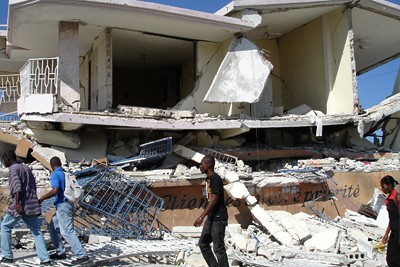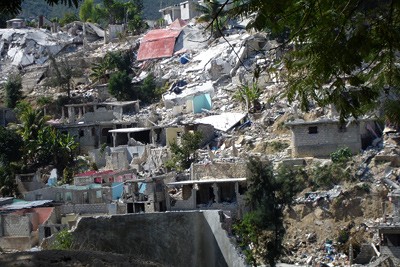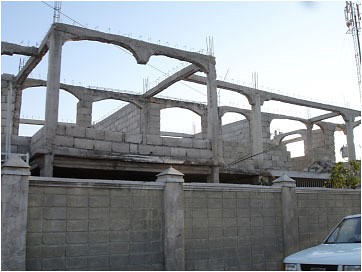Construction methods key to understanding Haiti damage
By Nancy Doolittle
The slide showed the skeleton of a Haitian building standing starkly against the sky.
"You would think that this is all that remains after the Haiti earthquake, but actually, this is a photo of a building that is still under construction, showing the common method and materials used for residential and light commercial buildings in Haiti," said Kenneth C. Hover, professor of civil and environmental engineering and a Weiss presidential fellow, in a presentation Jan. 29 in Hollister Hall.
The rest of the building, Hover said, would later have been finished using cast-in-place concrete and unreinforced concrete masonry blocks, noting that this kind of construction would not be expected to withstand the force of an earthquake such as occurred Jan. 12.
Providing a photographic tour of his recent Cornell-sponsored visit to Haiti to assess the damage to the buildings at Weill Cornell Medical College's GHESKIO clinic in Port-au-Prince, Hover noted that very little steel reinforcement, or rebar, was used in many Haitian buildings.
"There is only concrete in this region and masonry at the level of a home and cottage industry. Gentlemen set up on the sidewalk and sell bags of cement, others sell sand, others sell concrete blocks," he said. Homeowners buy these items when they have a little extra cash, he said, sometimes building a home a few blocks at a time.
Hover was asked to visit Haiti to help evaluate Cornell's three medical clinics in that country for both immediate needs and occupancy, and to inform planning for future rehabilitation. He provided recommendations on which buildings are still safe to use and which could be repaired. A few of those in the Port-au-Prince clinic survived the earthquake but are structurally compromised because of poor soil conditions where a bay had been filled in over the years.
Thanks to the leadership provided by clinic Director Dr. Jean W. Pape and his staff, the GHESKIO clinics continue to provide regional medical care and conduct advanced AIDS and tuberculosis research. The clinic and an adjacent U.S. field hospital provide emergency care to the injured and shelter and water to the more than 5,000 refugees who now live within the clinic boundaries.
"The Haiti people are resilient," Hover said. "In the midst of all the destruction and chaos, you can see where some of the boys have carved out space for a pick-up game of soccer," he said.
Hover is attending the World of Concrete convention in Las Vegas, where he will be speaking on "Concrete and Masonry in the Recent Haitian Earthquake."
Media Contact
Get Cornell news delivered right to your inbox.
Subscribe

